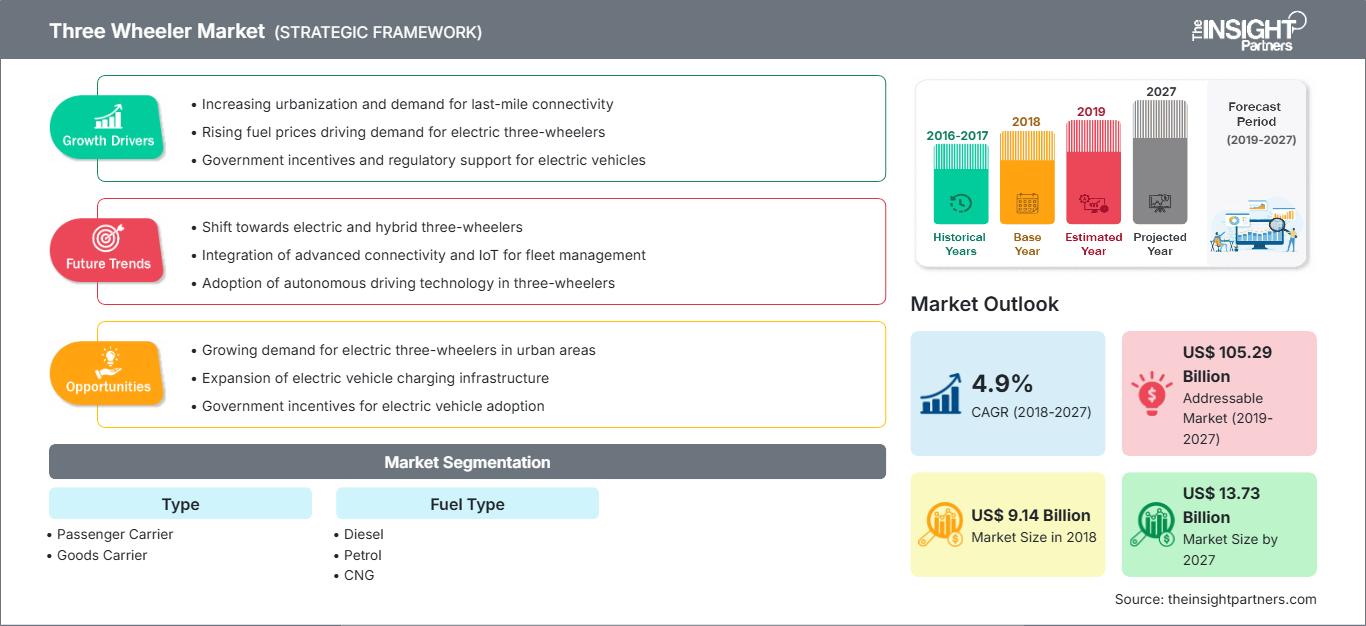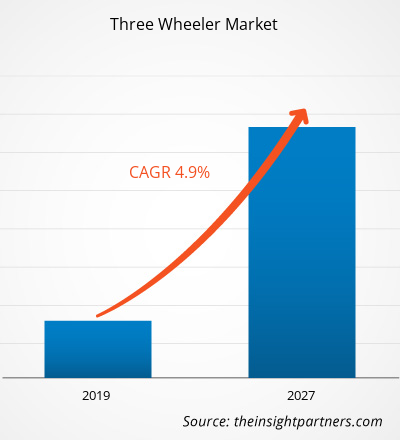2018 年三轮车市场价值为 91.4 亿美元,预计 2019 年至 2027 年的复合年增长率为 4.9%,到 2027 年将达到 137.3 亿美元。
三轮客运车是用于运送乘客的三轮车。三轮客运车至少可搭载三名乘客,最多可搭载五六名乘客。在农村地区,根据需要,六名以上的乘客可乘坐三轮客运车。电动人力车是三轮车的主要类型之一。电动人力车采用电池驱动,是一种环保车辆,与传统三轮车相比,其车辆排放更少,噪音更小。电动人力车可搭载五六名乘客进行运输。电动三轮车需求的不断增长、人口的增长以及对缓解交通拥堵车辆的需求的不断增长,推动了全球三轮车市场的增长。2018年,预测期内,亚太地区在三轮车市场中占据突出地位。预计在预测期内,印度等国家将在国内和出口业务领域占据主导地位。此外,许多来自印度的成熟企业正专注于生产符合BS(巴拉特阶段)VI标准的三轮车,该标准将于2020年实施,旨在控制颗粒物、氮氧化物和硫的排放。由于农村和半城市地区对交通工具的需求不断增长以及人口不断增长,中国出现了显著增长,其次是泰国和马来西亚等其他亚洲国家。
自定义此报告以满足您的要求
您将免费获得任何报告的定制,包括本报告的部分内容,或国家级分析、Excel 数据包,以及为初创企业和大学提供超值优惠和折扣
三轮车市场: 战略洞察

-
获取本报告的主要市场趋势。这个免费样本将包括数据分析,从市场趋势到估计和预测。
全球汽车行业正在经历数家新三轮车制造商的崛起。三轮车制造商不断关注电动三轮车市场的发展,因为该领域正在吸引全球客户的兴趣。全球汽车行业正在经历从传统三轮车到电动三轮车的重大转变。
各国政府都在主动采用电动三轮车。例如,2018 年 3 月,印度重工业和公共企业部启动了 FAME 印度计划第二阶段,该计划于 2019 年 4 月 1 日启动,为期三年,总预算支持额为 13.9 亿美元。这一阶段的启动主要是为了支持公共和私营部门的电气化。共享交通,旨在通过补贴支持 7000 辆电动公交车、50 万辆电动三轮车、55000 辆电动四轮乘用车和 100 万辆电动两轮车。FAME 计划的这一阶段希望建立足够的公共充电基础设施,以建立电动汽车用户的信心。为此,重工业和公共企业部期待各利益相关方参与并积极参与,包括工业和公共部门企业 (PSE) 和政府机构。市场的主要参与者正致力于开发电动汽车。例如,意大利机动车制造商 Piaggio & C. SpA 在其 Piaggio Ape Electrik 电动三轮车系列中推出了 Piaggio Ape E-City。E-auto 配备可更换锂离子电池,一次充电可行驶约 70-80 公里。此外,2019 年 8 月,欧拉汽车宣布将于 2020 年初在印度推出电动三轮轻型商用货车。
从地理位置上看,印度和中国拥有众多三轮车制造商,电动三轮车的普及率也逐年飙升。除印度和中国外,巴西、阿根廷等南美国家以及南非、尼日利亚、埃及等中东和非洲国家在汽车行业采用电动三轮车方面也发展迅速。亚太地区在汽车行业占据主导地位,并且正在经历巨大的增长。尽管如此,在该地区运营的汽车企业需要与零部件供应商建立更多合作伙伴关系,以便在电动三轮车部署方面实现指数级增长。与其他市场参与者建立战略伙伴关系、开展合作、签订合同和收购是行业参与者推动市场发展的主要因素,预计这将在未来几年推动全球三轮车市场的发展。
类型洞察
在类型细分中,客运车在全球三轮车市场占据最大份额。客运车是各种私人运输运营商和以运输工作为生的个人能够负担得起的最便宜的运输工具。该细分市场的增长是由对低成本客运车日益增长的需求推动的,例如缺乏合适的道路,三轮车主要由于交通设施不足以及交通拥堵严重的城市地区。
燃料类型洞察
按燃料类型,三轮车市场分为柴油、汽油、压缩天然气 (CNG)、液化石油气 (LPG) 和电动。汽油细分市场在全球三轮车市场占据主导地位。
主动性是公司为扩大其全球影响力并满足不断增长的客户需求而采取的一种策略。三轮车市场的参与者主要专注于通过集成先进的功能和技术来增强产品和服务。通过在世界各地签署合作伙伴关系、签订合同、建立合资企业以及开设新办事处,各公司正努力提升市场份额和品牌影响力。大多数市场举措都集中在亚太地区,该地区未来市场增长潜力巨大。以下列举其中一些举措:
2019年:2019年12月,Greaves Cotton宣布与TVS Motor Company建立合作伙伴关系。根据此次合作,Greaves Cotton将成为TVS Motor在印度的三轮车授权服务中心。2018年:ATUL Auto Limited与总部位于印度的汽车零部件公司JBM Industries合作。双方合作将拓展其三轮电动车业务。
三轮车市场
The Insight Partners 的分析师已详尽阐述了预测期内影响三轮车市场的区域趋势和因素。本节还讨论了北美、欧洲、亚太地区、中东和非洲以及南美和中美洲的三轮车市场细分和地域分布。
三轮车市场报告范围
| 报告属性 | 细节 |
|---|---|
| 市场规模 2018 | US$ 9.14 Billion |
| 市场规模 2027 | US$ 13.73 Billion |
| 全球复合年增长率 (2018 - 2027) | 4.9% |
| 历史数据 | 2016-2017 |
| 预测期 | 2019-2027 |
| 涵盖的领域 |
By 类型
|
| 覆盖地区和国家 |
北美
|
| 市场领导者和主要公司简介 |
|
三轮车市场参与者密度:了解其对商业动态的影响
三轮车市场正在快速增长,这得益于终端用户需求的不断增长,而这些需求的驱动因素包括消费者偏好的演变、技术进步以及对产品优势的认知度不断提高。随着需求的增长,企业正在扩展产品线,不断创新以满足消费者需求,并抓住新兴趋势,从而进一步推动市场增长。

- 获取 三轮车市场 主要参与者概述
- 客运
- 货运
三轮车市场 -
按燃料类型- 柴油
- 汽油
- 压缩天然气
- 液化石油气
- 电动
按地区划分的全球三轮车市场
-
北美
- 美国
- 加拿大
- 墨西哥
-
欧洲
- 法国
- 德国
- 意大利
- 英国
- 俄罗斯
- 欧洲其他地区
-
亚太地区
- 中国
- 印度
- 韩国
- 日本
- 澳大利亚
- 亚太其他地区
-
其他地区全球
- 非洲
- 拉丁美洲
公司简介
- ATUL Auto Limited
- Bajaj Auto Ltd.
- JS AUTO (P) LTD.
- Mahindra & Mahindra Ltd.
- Piaggio & C. SpA
- Scooters India Limited
- Speego Vehicles Co Pvt Limited
- Terra Motors Corporation
- TVS Motor Company
- 香河强盛电动三轮车厂
- 历史分析(2 年)、基准年、预测(7 年)及复合年增长率
- PEST和SWOT分析
- 市场规模、价值/数量 - 全球、区域、国家
- 行业和竞争格局
- Excel 数据集
近期报告
相关报告
客户评价
购买理由
- 明智的决策
- 了解市场动态
- 竞争分析
- 客户洞察
- 市场预测
- 风险规避
- 战略规划
- 投资论证
- 识别新兴市场
- 优化营销策略
- 提升运营效率
- 顺应监管趋势






















 获取免费样品 - 三轮车市场
获取免费样品 - 三轮车市场